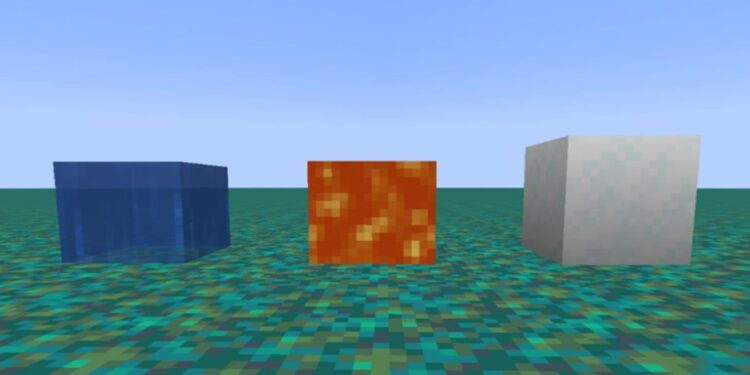Minecraft is a game of endless creativity and exploration, but it also incorporates complex mechanics that make the world feel more dynamic and realistic. One of the key aspects of Minecraft’s farming system is the water block, which plays a crucial role in hydrating farmland. Whether you’re a beginner or a seasoned player, understanding how the water block Minecraft mechanics work can significantly improve your efficiency when setting up farms. In this guide, we’ll explore how water blocks function, how their texture affects gameplay, and answer common questions like how many blocks does one block of water hydrate in Minecraft and how far can a water block hydrate Minecraft farmland.
Before diving into the details of water blocks, it’s worth noting that for large-scale multiplayer servers, a reliable server host is essential. Services like minecraft hosting Godlike offer the performance and stability required to support complex mechanics like water block hydration on a larger scale, ensuring a smooth and uninterrupted gaming experience.
The Role of Water Blocks in Minecraft Farming
Water blocks are essential for farming in Minecraft. In the game, water can hydrate farmland blocks, enabling crops like wheat, carrots, and potatoes to grow efficiently. Without adequate hydration, farmland will dry out and eventually revert to dirt, which prevents crops from growing. By understanding the mechanics behind the water block Minecraft, you can optimize your farm designs to maximize crop growth and resource efficiency.
Minecraft Water Block Texture: Visual and Functional Role
The Minecraft water block texture is more than just a visual element. While the appearance of water blocks can enhance the aesthetic of your builds, the texture also represents the block’s ability to interact with other game mechanics. Water in Minecraft flows and spreads when placed, filling empty spaces and creating infinite water sources when combined with other water blocks. However, its primary function for farming is to hydrate the surrounding farmland blocks.
Water blocks have a transparent texture, allowing players to see through them and making them perfect for decorative elements like pools or fountains. In farming, however, players are more concerned with how water hydrates nearby farmland, which is why understanding its functional role is key.
How Many Blocks Does One Block of Water Hydrate in Minecraft?
One of the most important questions for players setting up farms is: how many blocks does one block of water hydrate in Minecraft? The answer is straightforward: a single water block can hydrate farmland blocks up to four blocks away in all directions. This creates a hydration radius of 9×9 blocks, with the water block at the center.

In simpler terms, a single water block hydrates a square of farmland that is 9 blocks wide and 9 blocks long, meaning it covers a total area of 81 blocks. This makes the water block highly efficient, as just one block of water is enough to hydrate a large section of your farm. Understanding this mechanic helps players design farms with fewer water sources, allowing for more farmland and better crop yields.
How Far Can a Water Block Hydrate Minecraft Farmland?
To expand on the previous point, it’s important to know how far can a water block hydrate Minecraft farmland. As mentioned earlier, a water block hydrates farmland up to four blocks away in any direction. This distance includes diagonals, meaning a water block placed in the center of a 9×9 square will hydrate all the farmland within that square.
The hydration mechanic operates in such a way that you can plant crops in a large area while only using minimal water. This allows for more efficient farm designs, as you won’t need to constantly place water blocks close together. Instead, you can space them out and still maintain fully hydrated farmland.
How Much Farmland Can One Water Block Hydrate in Minecraft?
Now that we’ve established the distance water blocks can hydrate, the next logical question is: how much farmland can one water block hydrate in Minecraft? The answer is simple: a single water block hydrates up to 80 farmland blocks. This is calculated based on the 9×9 square (81 blocks in total) minus the block occupied by the water itself.
This efficiency makes it possible to design large farms with minimal water sources, maximizing the available space for crops. By strategically placing water blocks, you can create expansive, fully hydrated farms that produce large quantities of crops without needing to dedicate too much space to water placement.
Practical Tips for Using Water Blocks in Your Farm Designs
Knowing the basic hydration mechanics of water blocks in Minecraft allows you to design more effective and efficient farms. Here are some practical tips to make the most of water blocks:
- Use Fewer Water Blocks: Since one water block can hydrate up to 80 farmland blocks, you can space out your water sources every five blocks, creating more room for crops.
- Optimize Your Layout: A 9×9 farm layout with a water block in the center ensures that all farmland is hydrated. This is the most efficient layout for maximizing crop yield with minimal water sources.
- Infinite Water Source: If you need to create more water blocks for your farm, you can set up an infinite water source by placing two water blocks in opposite corners of a 2×2 space. This trick ensures you always have access to water without needing to venture back to a river or lake.
- Cover Water Blocks: You can place slabs or trapdoors over water blocks without stopping their ability to hydrate farmland. This trick is helpful for preventing accidental falls into the water and keeping your farm layout neat.
- Underground Water: Water blocks can be hidden under other blocks, such as dirt or slabs, and still hydrate farmland above them. This technique is great for creating seamless, aesthetic farms where the water source is concealed.
Conclusion
The water block Minecraft mechanic is one of the key elements of farming in the game. Understanding how hydration works, including how many blocks one block of water hydrates in Minecraft and how far a water block can hydrate Minecraft farmland, allows you to optimize your farm designs for maximum efficiency. By utilizing the water block’s ability to hydrate up to 80 farmland blocks, players can create expansive farms with minimal resources, increasing crop yields while conserving space.
With the right approach, you can easily incorporate water blocks into your farms, ensuring that all your crops are hydrated and ready to grow. Whether you’re playing on a personal server or hosting large multiplayer farms on platforms like Godlike, mastering water block mechanics will help you get the most out of your Minecraft farming experience.



















